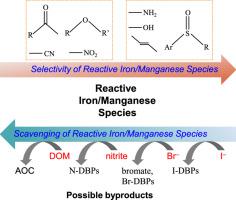Water Research ( IF 11.4 ) Pub Date : 2022-06-16 , DOI: 10.1016/j.watres.2022.118765 Binbin Shao 1 , Hongyu Dong 2 , Gongming Zhou 1 , Jun Ma 3 , Virender K Sharma 4 , Xiaohong Guan 1

|
Many iron(II, III, VI)- and manganese(II, IV, VII)-based oxidation processes can generate reactive iron/manganese species (RFeS/RMnS, i.e., Fe(IV)/Fe(V) and Mn(III)/Mn(V)/Mn(VI)), which have mild and selective reactivity toward a wide range of organic contaminants, and thus have drawn significant attention. The reaction mechanisms of these processes are rather complicated due to the simultaneous involvement of multiple radical and/or nonradical species. As a result, the ambiguity in the occurrence of RFeS/RMnS and divergence in the degradation mechanisms of trace organic contaminants in the presence of RFeS/RMnS exist in literature. In order to improve the critical understanding of the RFeS/RMnS-mediated oxidation processes, the detection methods of RFeS/RMnS and their roles in the destruction of trace organic contaminants are reviewed with special attention to some specific problems related to the scavenger and probe selection and experimental results analysis potentially resulting in some questionable conclusions. Moreover, the influence of background constituents, such as organic matter and halides, on oxidation efficiency of RFeS/RMnS-mediated oxidation processes and formation of byproducts are discussed through their comparison with those in free radicals-dominated oxidation processes. Finally, the prospects of the RFeS/RMnS-mediated oxidation processes and the challenges for future applications are presented.
中文翻译:

活性铁/锰对有机污染物的降解:进展与挑战
许多基于铁 (II, III, VI) 和锰 (II, IV, VII) 的氧化过程可以产生活性铁/锰物质 (RFeS/RMnS,即 Fe(IV)/Fe(V) 和 Mn(III) )/Mn(V)/Mn(VI)),它们对多种有机污染物具有温和和选择性的反应性,因此受到了极大的关注。由于多种自由基和/或非自由基物质的同时参与,这些过程的反应机制相当复杂。因此,文献中存在 RFeS/RMnS 发生的模糊性和微量有机污染物在 RFeS/RMnS 存在下降解机制的分歧。为了提高对 RFeS/RMnS 介导的氧化过程的批判性理解,回顾了 RFeS/RMnS 的检测方法及其在破坏痕量有机污染物中的作用,特别关注了与清除剂和探针选择相关的一些具体问题,以及可能导致一些有问题的结论的实验结果分析。此外,通过与自由基主导的氧化过程的比较,讨论了背景成分(如有机物和卤化物)对 RFeS/RMnS 介导的氧化过程的氧化效率和副产物形成的影响。最后,介绍了 RFeS/RMnS 介导的氧化过程的前景和未来应用的挑战。











































 京公网安备 11010802027423号
京公网安备 11010802027423号